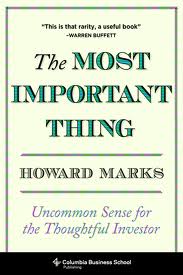This concludes our series on portfolio management highlights from Howard Marks’ book, The Most Important Thing: Uncommon Sense for the Thoughtful Investor, Chapter 19 “The Most Important Thing Is…Adding Value” Trackrecord, Compounding, Capital Preservation
“It means relatively little that a risk taker achieves a high return in a rising market, or that a conservative investors is able to minimize losses in a decline. The real question is how they do in the long run and in climates for which their style is ill suited…Without skill, aggressive investors move a lot in both directions, and defensive investors move little in either direction…
Aggressive investors with skill do well in bull markets but don’t’ give it all back in corresponding bear markets, while defensive investors with skill lose relatively little in bear markets but participate reasonably in bull markets. Everything in investing is a two-edged sword and operates symmetrically, with the exception of superior skill.”
“The performance of investors who add value is asymmetrical. The percentage of the market’s gain they capture is higher than the percentage of loss they suffer…Only skill can be counted on to add more in propitious environments than it costs in hostile ones. This is the investment asymmetry we seek.”
“In good years in the market, it’s good enough to be average. Everyone makes money in the good years...There is a time, however, when we consider it essential to beat the market, and that’s in the bad years…it’s our goal to do as well as the market when it does well and better than the market when it does poorly. At first blush that may sound like a modest goal, but it’s really quite ambitious. In order to stay up with the market when it does well, a portfolio has to incorporate good measure of beta and correlation with the market. But if we’re aided by beta and correlation on the way up, shouldn’t they be expected to hurt us on the way down? If we’re consistently able to decline less when the market declines and also participate fully when the market rises, this can be attributable to only one thing: alpha, or skill…Asymmetry – better performance on the upside than on the downside relative to what our style alone would produce – should be every investor’s goal.”
For more on the topic of asymmetry, be sure to check out our article titled “Asymmetry Revisited”
Volatility
“A portfolio with a beta above 1 is expected to be more volatile than the reference market, and a beta below 1 means it’ll be less volatile. Multiply the market return by the beta and you’ll get the return that a given portfolio should be expected to achieve…If the market is up 15 percent, a portfolio with a beta of 1.2 should return 18 percent (plus or minus alpha).”
We often find common threads between different investors. For example, there is evidence that Buffett was thinking about expected beta as early as the 1950s and 1960s (back in the day when he did not have permanent capital) -- see our articles on Buffett Partnership Letters and Volatility.
Expected Return, Risk
“Although I dismiss the identity between risk and volatility, I insist on considering a portfolio’s return in the light of its overall riskiness…A manager who earned 18 percent with a risky portfolio isn’t necessarily superior to one who earned 15 percent with a lower-risk portfolio. Risk-adjusted return holds the key, even though – since risk other than volatility can’t be quantified – I feel it is best assessed judgmentally, not calculated scientifically.”
“‘beating the market’ and ‘superior investing’ can be far from synonymous…It’s not just your return that matters, but also what risk you took to get it…”
Opportunity Cost, Benchmark
“…all equity investors start not with a blank sheet of paper but rather with the possibility of simply emulating an index...investors can decide to deviates from the index in order to exploit their stock-picking ability…In doing so they will alter the exposure of their portfolio to…price movements that affect only certain stocks, not the index…their return will deviate as well."
We are all faced with this choice that, at a minimum, we can emulate an index. If we choose not to, it’s because we believe we can generate outperformance via higher returns and same risk, similar returns at lower risk, or higher returns at lower risk. If we cannot accomplish any of the above, then we have failed to do better than an index (and failed to add value as investors). But if we did not have an index or benchmark against which to measure progress, how would we know whether we have succeeded or failed?


